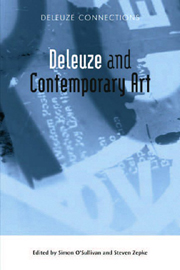Introduction: Deleuze and Guattari and Contemporary Art
Published online by Cambridge University Press: 12 September 2012
Summary
The artist stores up his treasures so as to create an immediate explosion.
Deleuze and Guattari, Anti-OedipusConjunction Versus the Relational
Deleuze and Guattari and Contemporary art. Our emphasis lies squarely on the conjunction, on what it might mean and what it might be able to do. How can we articulate or even explode this conjunction, now and for a future to come? What is at stake is an actualisation of Deleuze and Guattari's ‘logic of the AND’; an actualisation in action, a pragmatics that is not a ‘localisable relation going from one thing to the other and back again’, but a ‘transversal movement that sweeps one and the other away, a stream without beginning or end that undermines its banks and picks up speed in the middle’ (Deleuze and Guattari 1988: 28). Following this ‘stream’ that erodes its own banks, we cannot imagine that this relationship, this and, could be articulated by either ‘philosophy’ or ‘art’, at least in their traditional forms. As many of the essays here argue, Contemporary art is a field that seems to attack the very ground of this old distinction. Indeed, perhaps Contemporary art is a field of production (we would say a future) that ignores the line Deleuze and Guattari draw between concepts and sensations. In this sense then, the volume offers a cross-section of the encounter of Deleuze and Guattari and Contemporary art, an encounter that might irradiate our ‘present’ with the ‘crepuscular light’ of an and in which they become indistinct.
- Type
- Chapter
- Information
- Deleuze and Contemporary Art , pp. 1 - 12Publisher: Edinburgh University PressPrint publication year: 2010

